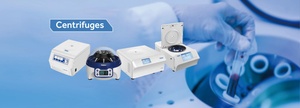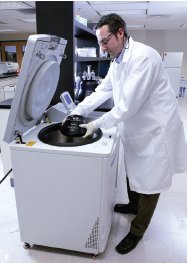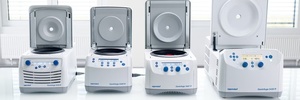Centrifuges and Microcentrifuges
Compact centrifuges designed to fit on lab workbenches and other smaller stations for general and special purposes, clinical settings, and more. Includes a wide variety of rotor and speed combinations. Also includes accessories and replacement parts. Centrifuges are often placed on the benchtop or work surface for easy and immediate access. Options include general-purpose, clinical, compact, and special-purpose benchtop centrifuges. These devices may be ventilated (operated without temperature controls), refrigerated, or heated. Units may be sold with or without rotors, and rotor options may also be available. The choice of rotor will determine the maximum number of samples that can be processed simultaneously and will help determine the maximum g-force or speed that can be achieved. In fixed-angle rotors, the tubes remain the same angled position while being spun. In contrast, as the rotational speed increases, samples in swinging bucket rotors spin in a horizontal position. The type of rotor also affects where the solids 'pellet' forms — on the side (fixed-angle) or the bottom (swinging-bucket) of the tube. Swinging-bucket rotors can also tolerate higher speeds, an important factor when separating biological macromolecules. View More View Less
Glass and plastic tubes designed for use in centrifuges; available in a variety of volume capacities, materials, configurations, RCF ratings, and closure types; may be sterile or non-sterile; may have graduations indicating volume on the tube. Centrifuge tubes are used to contain liquids during centrifugation, which separates the sample into its components by rapidly rotating it around a fixed axis. Most centrifuge tubes have conical bottoms, which help collect any solid or heavier parts of the sample being centrifuged. Centrifuge tubes must also be able to withstand the centrifugal pressure created during their use, and their specifications may indicate the maximum speed at which they can be safely used. Centrifuge tubes are available in various styles, sizes, and materials Capacities: Range from 0.1mL to more than 100mL; the most common sizes are 15mL and 50mL (centrifuge) and 1mL and 2mL (microcentrifuge) Closures: Screw-on plugged or flat caps; may be attached or separate Markings: May have writing areas, graduations, or other markings Shape: Conical- or round-bottomed; if conical, choose skirted free-standing versions Material: Glass or plastic resin; the latter include polypropylene, polystyrene, PET, and PPCO Sterility: Sterile or nonsterile; may be heat- or gas-sterilized Packaging: Bulk or racked tubes Color: Choose amber or black plastics for light-sensitive samples View More View Less
Floor-standing centrifuges for routine laboratory procedures. Frees up benchtop workspace in a wide range of environments. Includes low and superspeed models, ultracentrifuges, general purpose models, and replacement parts and accessories. Floor model centrifuges have larger capacities and can operate at higher speeds. Types of floor model centrifuges include general purpose, low-speed (RCF maximum of 7000 × g), superspeed (70,450 × g max. speed), and ultracentrifuges (g-forces up to 1,000,000 × g). Rotor options for floor model centrifuges are available. View More View Less
ompact footprint centrifuges used for small sample sizes, such as microtubes. Ideal for microfilter cell separations and HPLC samples. Available as electronic or handheld manual units; may have digital interfaces and refrigeration capabilities. Microcentrifuges are specifically designed to accommodate tubes that hold less than 5.0 mL. Although benchtop centrifuges can be fitted with rotors for microtubes, microcentrifuges usually have a smaller footprint, which makes for a less-crowded work area. As with other benchtop centrifuges, these units can be ventilated (operated without temperature controls) or refrigerated. Most are sold with a rotor, although additional alternate rotors may be available. View More View Less




 0
0




